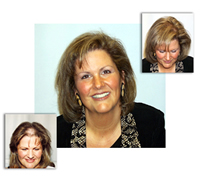Hair replacement for women is available
Women are much less likely than men to experience significant hair loss as they age. Although this sounds promising, you are not alone if you are experiencing the trauma of hair loss. At present there are over 20 million American women who suffer from hair loss, of which 10 million are under 40 years of age.
At HairBuilders of Portland we understand how your hair loss affects you as a woman. Maybe you just need to talk to someone who realizes how deeply your daily living is impacted both personally and in business if you are suffering from hair loss. Please contact us if you need help. One of our experts would be happy to consult with you personally, discuss your options, and show you how we can make your life happier with women’s hair replacement.
In women, the follicles programmed to stop growing are usually spread diffusely throughout the scalp, rather than at the hairline or crown. Overall thinning may result, but bald spots and receding hairlines are rare.
Estrogen hormones can counteract the effects of the hormone usually responsible for hair loss. Women have more estrogen in their blood system than do men, so even those with a genetic predisposition to hair loss may be protected. However, estrogen levels decrease at menopause, which is when many women first notice hair loss.
In the United States, approximately 21 million women are estimated to have the androgenetic alopecia predisposition.
Androgenetic alopecia is the scientific name for the genetic predisposition in both men and women for pattern baldness or pattern hair loss. Androgenetic alopecia is the cause of over 95% of all pattern hair loss, including baldness in men and thinning hair in women. Pattern hair loss occurs in somewhat predictable stages, and is relentlessly progressive. This means that those with pattern hair loss will, if they live long enough, eventually progress from the early stages of loss to the advanced stages. We all suffer hair loss; some people just arrive at the advance stages of hair loss sooner than others. Studies have shown that pattern loss is increasingly evident and advanced as people age.

Estrogens: Other hormones included in a class known as estrogens, can inhibit or counteract the follicle-shrinking effect of the androgens. Women generally have more estrogens circulating in their blood than men. As a result of this higher level of estrogens, even women having a genetic predisposition for pattern hair loss are protected from losing their hair because of the high level of estrogen in their blood.
Menopause: When these women reach menopause however, their estrogen level may decrease sufficiently, and the hair loss message may start to get through to the genetically programmed follicles. Their hair can begin to thin, sometimes dramatically. Exposure Time, Not Hormone Quantity: The time period for exposure to DHT is a critical factor in pattern hair loss, and it can take many decades for some genetically programmed follicles to get the message to stop producing hairs. The specific way that time duration affects pattern hair loss is not completely understood. It is the genetically programmed receptiveness of the hair follicles, and an adequate amount of time, not the amount of hormones, that cause hair follicle shrinkage, and the hair thinning that results. People with thin hair have the same amount of testosterone as those with thick hair. The difference is in their hair follicle’s genetically programmed receptiveness to DHT. Even on the same person’s head, where all the follicles have the same exposure to hormones in the blood, some follicles are programmed to keep growing, while others begin to spend more time resting.
Genetic Program is the Cause: Pattern hair loss is not the result of “trapped hair follicles”, build-up of DHT, scalp oils, or anything else on the scalp, poor circulation, inadequate oxygen, constant stress, or inadequate nutrition. Pattern hair loss is simply the result of genetic programming of hair follicle cells and the exposure of the cells to hormones in the blood over a long period of time.
No Cure; Only Treatments: At present there is no cure for androgenetic alopecia. There is nothing that will stop the condition once and for all. There are however, many treatments for this form of hair loss, and each has advantages and disadvantages. Treatments and hair replacement are described in detail in other parts of this site. Some hair loss treatments for women are designed primarily to separate those with thin hair from their money, rather than restore hair.
Get a real solution! Schedule a confidential consultation with one of our hair replacement experts. We will work with you personally and confidentially to develop a solution using the latest technology unique to your needs.
Visit us and see what we are all about!
Call us to schedule a free consultation at (207) 536-4881 or email us [email protected]
